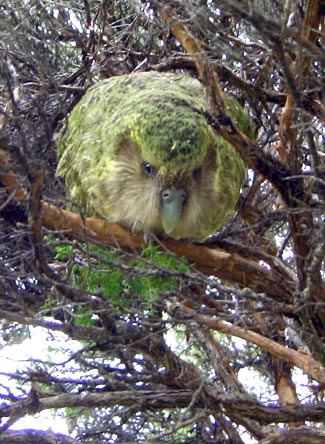 Sirocco the kakapo looks down on photographer Mike Bodie from his treetop perch. Photo: Department of ConservationA Momentous Waitangi Day on Whenua Hou/Codfish Island has seen a male kakapo rediscovered 21 years after vanishing and world-first artificial insemination using the sole surviving Fiordland kakapo.
Sirocco the kakapo looks down on photographer Mike Bodie from his treetop perch. Photo: Department of ConservationA Momentous Waitangi Day on Whenua Hou/Codfish Island has seen a male kakapo rediscovered 21 years after vanishing and world-first artificial insemination using the sole surviving Fiordland kakapo.
Rangi's miraculous find by kakapo ranger Chris Birmingham boosts the critically endangered endemic parrot population to 91 and potentially adds important genetic diversity.
The flightless nocturnal bird was one of four male kakapo released on the 1400ha conservation sanctuary, near Stewart Island, in 1987 without a transmitter. He had not been seen since.
Birmingham told the Sunday Star-Times he was surprised to hear a male booming, its unique resonant mating call, near South Bay, where no kakapo had been detected before.
"I followed the booming sound and eventually spotted him. He bolted so I followed him through the supplejack and ferns. Finally, when it was safe, I managed to grab him."
It was only then that he realised the bird's significance because it wore a numbered metal band on his leg. Incredibly, Rangi survived two aerial poison drops during Codfish Island's rat eradication in 1998.
Once Rangi's vitals were checked, showing he was in top form, sperm was collected from him before he was carefully carried back to home territory and released. He vanished within seconds into the island's thick undergrowth, but has now been fitted with a transmitter to ensure his days of anonymity are over.
Tests later that day at a makeshift laboratory on the island showed he had high quality sperm. DNA research was also planned.
Rangi's discovery could improve the species chances if he is genetically different to the other birds, the kakapo team's technical officer, Daryl Eason said. "Every kakapo is important. Rangi was a founder bird and he could be a very important bird."
Meanwhile on Friday, Richard Henry, the only surviving Fiordland kakapo (the rest were caught on Stewart Island or were their descendants), gave what could be his last shot at fatherhood.
For the first time ever, sperm was collected from the bird, which is estimated to be at least 70 years old.
Although checks showed it to be poor-quality, it was used to artificially inseminate a female kakapo to try for more offspring with his valuable diverse genes.
"Anything's worth a try with him but it may be too late," Eason said.
Spanish vet Dr Juan Blanco, a world-renowned expert in assisted reproductive techniques in endangered birds, was also on the island developing artificial insemination of kakapo.
He made international history 12 days ago by becoming the first person to artificially inseminate a wild endemic endangered bird. The female kakapo had since laid two eggs, raising hopes of success. The insemination of the kakapo with Richard Henry's sperm was only the second effort at using the cutting-edge technique.
The goal was to boost fertility rates of eggs and to improve genetic diversity, which would help stave off kakapo extinction, Blanco said.
Waitangi Day's developments further improve what was predicted to be the biggest kakapo breeding season since monitoring began more than 30 years ago, sparked by heavy fruiting of rimu trees and the population's growing percentage of female kakapo.
Eason said predictions for 40 chicks were on track. By yesterday, 17 female kakapo had mated, seven had nested and 14 eggs laid, but more nests, eggs and matings were expected daily for weeks to come.